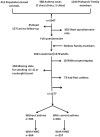Associations between nitric oxide synthase genes and exhaled NO-related phenotypes according to asthma status
- PMID: 22590587
- PMCID: PMC3348876
- DOI: 10.1371/journal.pone.0036672
Associations between nitric oxide synthase genes and exhaled NO-related phenotypes according to asthma status
Abstract
Background: The nitric oxide (NO) pathway is involved in asthma, and eosinophils participate in the regulation of the NO pool in pulmonary tissues. We investigated associations between single nucleotide polymorphisms (SNPs) of NO synthase genes (NOS) and biological NO-related phenotypes measured in two compartments (exhaled breath condensate and plasma) and blood eosinophil counts.
Methodology: SNPs (N = 121) belonging to NOS1, NOS2 and NOS3 genes were genotyped in 1277 adults from the French Epidemiological study on the Genetics and Environment of Asthma (EGEA). Association analyses were conducted on four quantitative phenotypes: the exhaled fraction of NO (Fe(NO)), plasma and exhaled breath condensate (EBC) nitrite-nitrate levels (NO2-NO3) and blood eosinophils in asthmatics and non-asthmatics separately. Genetic heterogeneity of these phenotypes between asthmatics and non-asthmatics was also investigated.
Principal findings: In non-asthmatics, after correction for multiple comparisons, we found significant associations of Fe(NO) levels with three SNPs in NOS3 and NOS2 (P ≤ 0.002), and of EBC NO2-NO3 level with NOS2 (P = 0.002). In asthmatics, a single significant association was detected between Fe(NO) levels and one SNP in NOS3 (P = 0.004). Moreover, there was significant heterogeneity of NOS3 SNP effect on Fe(NO) between asthmatics and non-asthmatics (P = 0.0002 to 0.005). No significant association was found between any SNP and NO2-NO3 plasma levels or blood eosinophil counts.
Conclusions: Variants in NO synthase genes influence Fe(NO) and EBC NO2-NO3 levels in adults. These genetic determinants differ according to asthma status. Significant associations were only detected for exhaled phenotypes, highlighting the critical relevance to have access to specific phenotypes measured in relevant biological fluid.
Conflict of interest statement
Figures
References
-
- Ricciardolo FLM, Di Stefano A, Sabatini F, Folkerts G. Reactive nitrogen species in the respiratory tract. Eur J Pharmacol. 2006;533:240–252. - PubMed
-
- Lundberg JO, Weitzberg E, Gladwin MT. The nitrate-nitrite-nitric oxide pathway in physiology and therapeutics. Nature Reviews. 2008;7:156–167. - PubMed
-
- Taylor DR. Risk assessment in asthma and COPD: a potential role for biomarkers? Thorax. 2009;64:261–264. - PubMed
-
- Gibson PG, Simpson JL. The overlap syndrome of asthma and COPD: what are its features and how important is it? Thorax. 2009;64:728–735. - PubMed


